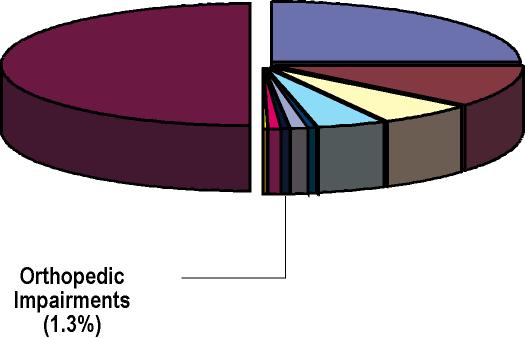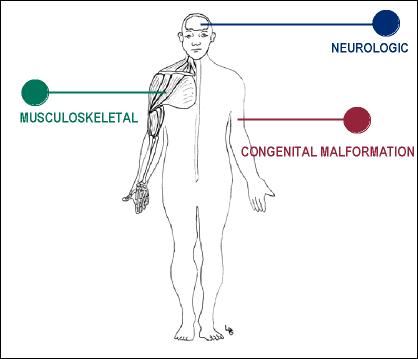| ESE424 : The Class : Mild Disabilities : OI : Orthopedic Impairments | |||||
Orthopedic Impairments
Definition
Orthopedic impairments are one of the diagnostic categories under the Individuals with Disabilities Education Act (IDEA).
Orthopedic impairment means "a severe orthopedic impairment that adversely effects a child's educational performance. The term includes impairments caused by congenital anomaly (E.g., clubfoot, absence of some member, etc.), impairments caused by disease (e.g., poliomyelitis, bond tuberculosis, etc.), and impairments from other causes (e.g., cerebral palsy, amputations, and fractrues or burns that cause contractures).
As you can readily see, orthopedic impairments, while much smaller in incidence, comprise a very broad, quite diverse catetory of disability. In this category are such conditions as cerebral palsy, muscular dystrophy, traumatic brain injury, epilepsy, and amputations or deletions of limbs. Equally as important, there is quite a range of potential disabilities and effects within and accross the category.
Despite the relative diversity of this category of disability, it comprises a small part of the overall special education population.

To simplify our learning task, I will present this topic by dividing this broad category of disability into three general categories of impairments: Neurologic conditions, musculoskeletal conditions, and congential malformations. Click on each type of orthopedic impairment to learn more about that category.

[Neurologic] [Musculoskeletal] [Congenital Malformation]
The figure below illustrates some of the more common conditions under each category. You have probably heard of several of these (if not all). In the remaining portion of this unit we will examine each of these condictions. I have included more detailed information on three of these conditions - cerebral palsy, epilepsy, and traumatic brain injury - because these are some of the most frequent conditions you will encounter as a teacher. Click on the name of each condition below for more detailed information.

Figure 8.1 Major Orthopedic Impairments
[epilepsy]
[cerebral
palsy] [traumatic
brain injury] [spinal
cord injury] [spina
bifida]
[muscular dystrophy]
[juvenile
rheumatoid arthritis] [polyarticular
juvenile rheumatoid arthritis][arthrogryposis]
[osteogenesis
imperfecta] [clubfoot]
[hip dysplasia]
[legg-calf perthes]
[congenital
malformations and limb deficiency]
Once you have finished you should:
Go on to
Other Health Impairments
or
Go back to Orthopedic
and Health Impairments
E-mail Larry Gallagher at Larry.Gallagher@nau.edu
Copyright © 2000 Northern Arizona
University
ALL RIGHTS RESERVED